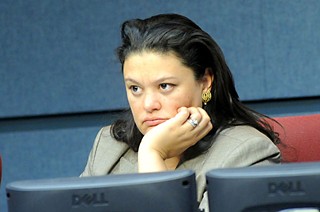AISD: Open Embargo, Find Plan
Carstarphen's AISD reveals a process inside a plan inside an embargo
By Richard Whittaker, Fri., Sept. 30, 2011
The latest announcement about the long-awaited Austin ISD Facility Master Plan was, among other things, supposed to signal a new era between the district and the local media. Instead, the release triggered a heated exchange between reporters and district staff that threatened to overshadow the plan itself.
On Monday, Sept. 26, new Director of Public Relations and Multicultural Outreach Alex Sánchez met with members of the media at the Carruth Administration Center to brief them on that evening's meeting of the board of trustees. Superintendent Meria Carstarphen was scheduled to present her latest master plan recommendations, beginning with a new structural process: an annual review of each building and how it fits into the district's general academic strategic plan. However, the press briefing soon became fractious when talk turned to the second part of the evening: Carstarphen's presentation of her draft proposals for the 2012-13 school year (see "For Planning Purposes," below). Sánchez told reporters they could have a copy of that draft at 2pm, but only if they signed a binding embargo promising not to release any details until Carstarphen's presentation at 10:40 that night. Cue a tense debate over why the district was demanding such a pledge – and effectively a day's delay in reporting the news – for what looked like a pretty vanilla agenda item.
Such embargoes, while commonly put in place by public relations teams for promotional reasons, are unusual in the public sector, and the Statesman had already rejected the district's strings-attached offer. On Sept. 24, the Statesman's editorial "What's in superintendent's secret plan?" reported the embargo request that it had rejected. If Carstarphen were to formally present the plans to the board, the daily argued, they were covered by the Texas Public Information Act and so should be available 72 hours before the meeting. The editors wrote, "We remind Carstarphen that she is running a school district, not managing a marketing firm."
Accordingly, Sánchez told reporters, "The Statesman ruined it for all of you." However, the daily was only the first of many local news outlets (including the Chronicle) that refused to agree. The consensus among reporters in the room, as well as their editors and general managers back at their offices, was that such an embargo was unnecessary and that signing the form would set a poor precedent. The Monday afternoon briefing ended with a disgruntled press corps aggressively questioning Sánchez and newsroom management weighing in by cell phone. (The Chronicle has requested any legal opinions from district general counsel Mel Waxler used to justify the embargo.)
As eventually delivered late Monday, Carstarphen's proposal effectively ends the idea of a 10-year strategic, districtwide facility master plan intended to answer fundamental questions about the overall direction of the district. Board President Mark Williams said that, in Carstarphen's new vision, "the plan is a process" rather than the anticipated "defined, set-in-stone plan." It's yet another twist in the long push to improve the district's facility planning, which reached a low point this spring when the Facility Master Plan Task Force got hijacked into being all about school closures (see "What the Task Force Wrought," May 27). The board asked Carstarphen to use that report as the basis for an administrative recommendation, moving it back to the strategic level. Now she wants annual facility reviews tying together strategic educational goals and facility conditions. With that change, at-large trustee Annette LoVoi told her fellow trustees: "'Plan' is a misnomer. That's an unfortunate name for this three-part process, because a 'plan' suggests some immediate decision."
The board is expected to formally adopt the new framework on Nov. 21. In the meantime, Sánchez said, Carstarphen will spend the next two months revising her proposals until she releases her final recommendations for the 2012-13 school year at 6pm on Dec. 9. She expects trustees to vote on it three days later on Dec. 12 – their final regular board meeting of the year – and the process will start again in January for the 2013-14 year.
For Planning Purposes
On Sept. 26, AISD Superintendent Meria Carstarphen released her draft annual facilities recommendations for the 2012-13 school year. There's nothing drastically new in them: The district has already discussed, in at least the broadest terms, large policy questions like ending the open transfer policies. Teacher and staff union Education Austin is already sounding out the idea of in-district charters, while the Baker Center and the Carruth Administration Center have been on the real estate market for months. However, this is the first time that Carstarphen has formally said that she's considering all these issues: If she proceeds with all the proposals, this could mean four schools being repurposed and major programmatic changes at another six.
Proposals Under Consideration
• Evaluate the transfer policy
• Two new single-sex middle schools, one for boys and one for girls
• Two new in-district charter schools
• Two-way dual language immersion programs at six schools
• A regional science, technology, engineering, and mathematics magnet program
• Close the Alternative Learning Center and Alternative Center for Elementary Students and replace them with a new Disciplinary Alternative Education Program
• Tackle elementary overcrowding in North Central Austin
• Make attendance boundary changes based on the other annual facility recommendations
• Evaluate bids on the Baker and Carruth administrative buildings, currently up for sale
Got something to say on the subject? Send a letter to the editor.









